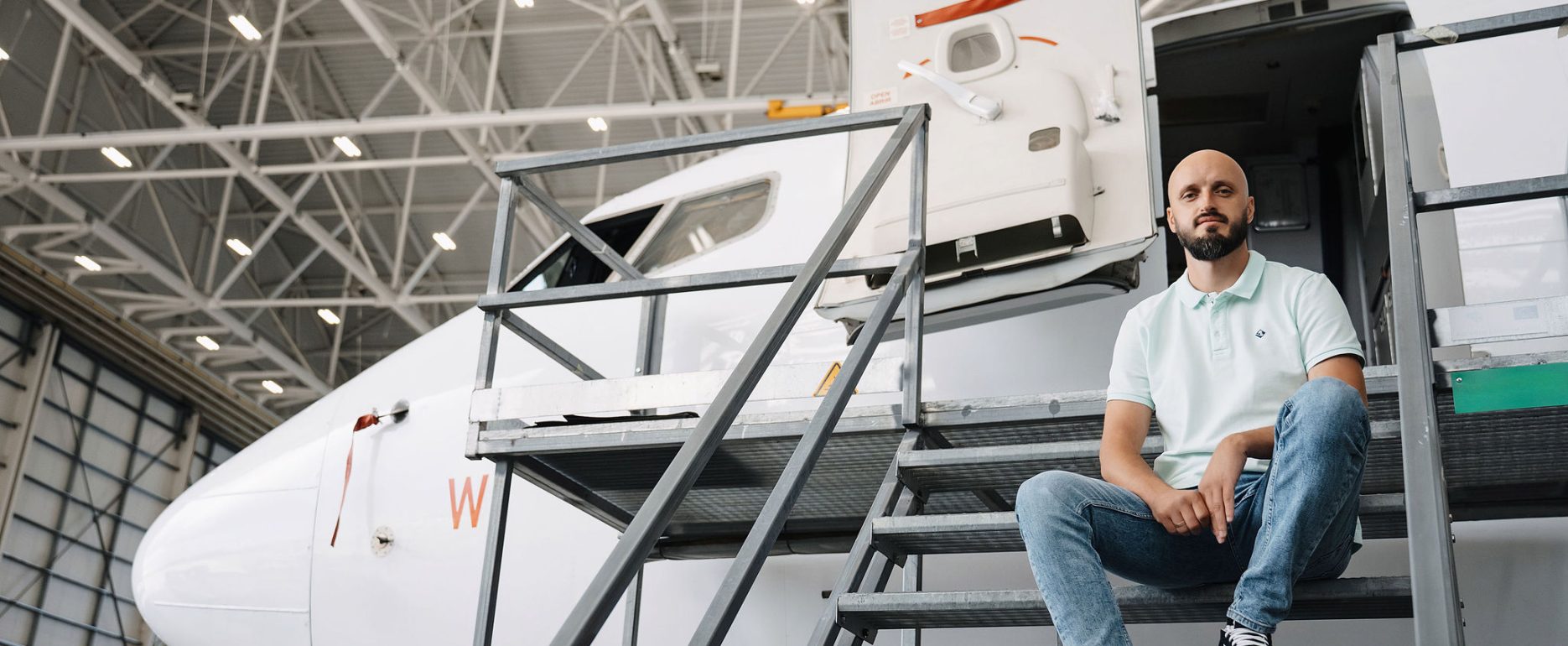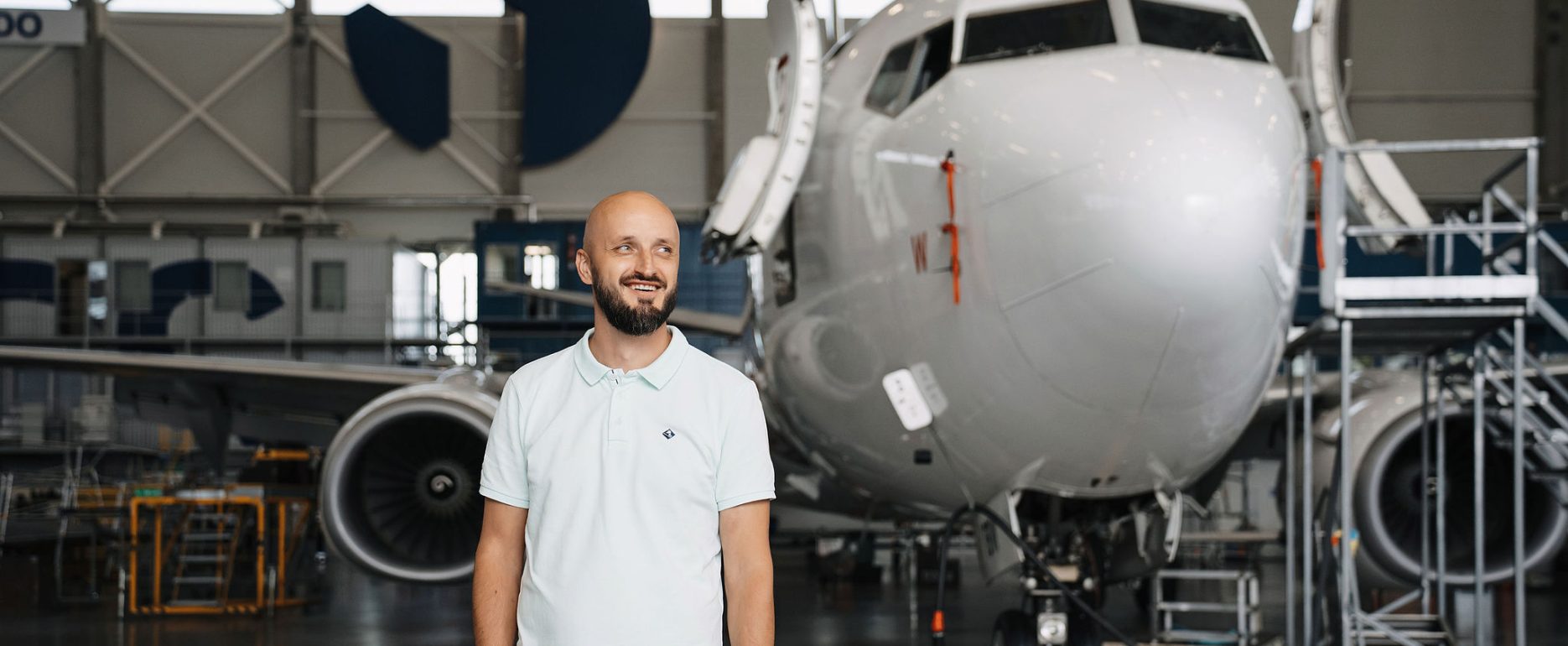What happens to an aircraft when the cabin doors close and passengers disembark after a flight? For some planes, the journey doesn’t end there – they are directed to a hangar for scheduled maintenance or more detailed inspections. Every detail matters here: from the smallest screw to meticulously completed documents, because any decision can impact flight safety.
Deividas Meškauskas, Deputy Production Manager at KUN (Kaunas) hangar at the aircraft maintenance company FL Technics, has been working in this field for nearly two decades. He started his career as a mechanic in the company’s VNO (Vilnius) hangar, gradually climbed the career ladder, and became the Deputy Production Manager at the Kaunas hangar. He knows well what responsibility, precision, and working in an international team mean. In this interview, Deividas talks about his path in aviation and shares advice for those considering a future in this industry.
According to him, there is no “secret to success” in an aviation career – only consistent work and responsibility for every detail. “It’s consistent, purposeful, well-practiced, but each step in your career requires not only competence but also personal maturity as a leader,” Deividas emphasizes.
How did your path in aviation begin – did you, as a child, look up at the sky and think your job could be related to airplanes?
Honestly, as a child I didn’t look at the sky dreaming of a career in aviation – it was more out of curiosity than a clear ambition. When finishing school, I chose fields that were considered popular and practical at the time – law, administration, civil engineering. Aviation engineering seemed like a beautifully sounding but little-known field – it was my “plan B” for studies.
However, fate took a different turn – I enrolled at the Antanas Gustaitis Aviation Institute, and in my fourth year, I started working as a mechanic. The beginning was not easy, but after six months, I could communicate with colleagues using technical terms, understand specifications, and be a full-fledged member of the team. Without a doubt, all technical aviation documentation is only in English. (Deividas smiles)
I received a lot of knowledge from my first aviation mentor – a technician who held the first Civil Aviation Administration (CAA) aircraft maintenance license issued after Lithuania regained independence. His experience, advice, and support were inspiring and helped me find my path in aviation. After two years, I became a certifying technician, then a project manager, and now I am the Deputy Production Manager in Kaunas. Throughout this time, I have worked in the same company – FL Technics. Here, I have grown not only as an aviation specialist or leader but still feel there is room for improvement.
What would you say to someone who thinks aircraft maintenance is just about screwing in bolts? What in this job is invisible but very important?
We often face two extreme opinions. Some imagine a technician as a person with a screwdriver, spending the whole day turning screws. Others think it’s almost a space-age field with incomprehensible technology. The truth lies somewhere in between, but closer to the second opinion.
Aviation is one of the most strictly regulated industries, where every action must be documented, justified by manufacturer instructions, and comply with European Union Aviation Safety Agency (EASA) or national regulatory procedures. There is simply no room for improvisation.
During routine maintenance, an aircraft can sometimes be disassembled down to its main structural parts: engines and landing gear are replaced, the cabin is dismantled for structural inspections, air conditioning systems, avionics, fuel tanks, flight control devices, and the fuselage are checked. Modifications, defect removal, and structural repairs are also carried out. It’s a highly complex process involving planners, engineers, quality control specialists, structural and composite material experts, painters, non-destructive testing (NDT) specialists, and supply/logistics departments. Everything is planned in advance – parts are ordered, work is scheduled, and resources are allocated. After each inspection, defects are analyzed, components are replaced – all according to strict procedures. Communication often involves the manufacturer (Airbus, Boeing, Embraer).
Additionally, there is a lot of invisible work: coordinating clients, meetings, reports, procurement, logistics, and finance. All of this is equally important and happens alongside the “tightened screw.”
What sounds, smells, or tiny details immediately tell you, as a technician, that something is wrong with an aircraft?
Technicians develop a kind of “sixth sense” through experience. I’ve flown many times on the Boeing 737 NG, and sitting over the wing, above the hydraulic compartment, I could hear a very specific sharp sound when slats were extended. That’s the standby pump activating when the main hydraulic system isn’t working.
Certain defects under the MEL (Minimum Equipment List) can be deferred – sometimes for a day, sometimes ten, even 120 days. They can also be limited by flight hours or cycles. The important thing is that the defect is properly assessed and documented. It’s safe. Everything is legal; passengers don’t notice, but an experienced technician immediately understands. Of course, I never comment on this to my relatives – it would just cause unnecessary panic. (Deividas smiles)
Every true aviator recognizes aircraft smells, especially in hangars, where the air is filled with the aroma of oils, lubricants, hydraulic fluids, and sealants. A single breath is enough to tell what substance is present. And there are other small details – technicians can often identify an aircraft type just by looking at an engine, cockpit, or wing shape. If the airline livery is visible, it’s immediately clear which aircraft and airline it belongs to.
What steps in aviation lead from mechanic duties to team leader? Are formal trainings or personal qualities more important?
Nothing in aviation happens overnight. A career is a step-by-step process, where each stage matters. First, basic aviation safety courses and internal company programs are completed. Then qualification upgrades begin: mechanic level 1, after a year – level 2, which requires specific knowledge of a particular aircraft.
After passing the Part-66 thirteen theoretical modules, completing practical training, and gaining the required experience, one becomes a certifying technician. There are exceptions for faster advancement, depending on education and other factors. Usually, it takes about five years.
But that doesn’t mean you’re ready to be a manager. A manager is not only the best aircraft specialist but also someone who can plan, organize, communicate, and resolve conflicts. They must know how to demand, help, and give feedback. Humor also helps, especially in stressful situations. Most importantly, a manager must earn authority through work, not position. In aviation, the cost of mistakes is too high for a manager to be just a formal supervisor. They must understand both the technical side and the people.
Not everyone can become a mechanic, and even fewer become a team leader. That’s why I say: a team leader isn’t appointed because of seniority or the “best screwdriver,” but because of the ability to inspire, lead, and be trusted. It’s not an assignment – it’s recognition.
What does a typical day in the Kaunas airport hangar look like – is there even such a thing as a typical day? Does working with clients and aircraft from different countries have its own specifics?
I couldn’t say there is a typical day in the hangar. The only constant is that usually four narrow-body aircraft are present. Everything else constantly changes: clients, aircraft models, defects, communication styles, cultures.
Over the years, I’ve worked with clients from more than 20 countries – from Turkmenistan, Armenia, and Moldova to Spain, Greece, the UK, the US, Vietnam, and Saudi Arabia. Each client is unique. Differences include not only technical specifications but also attitudes toward deadlines, decision-making speed, and communication culture. These are not written in any textbooks – you learn them through practice, experience, mistakes, and corrections. Over time, you begin to feel the person, recognize their expectations, and know when to be diplomatic and when to be clear and direct. Cultural differences have left a strong impression and significantly enriched my professional growth and intercultural communication skills.
Interestingly, it’s possible to predict what to expect from an aircraft arriving from a specific country – each market has its own maintenance traditions and standards, which can be seen in both documentation and aircraft condition. (Deividas smiles)
Without a doubt, aircraft are safe everywhere, regardless of region – they are the safest form of transport, where critical systems like flight control, electrical supply, engine operation, and hydraulics have not one but multiple backups – sometimes even three or four.
Was there a moment in your career when you thought, “This is why working in aviation is worth it”?
About five years ago, I participated in advanced engine testing training in the BAA simulator. It is identical to a real aircraft: sounds, visuals, loads, and movements are precisely replicated. The simulator often imitates unusual situations – for example, losing one or both engines. These are exactly the cases we, maintenance specialists, must prevent in reality.
During the training, I successfully piloted the A320 simulator, landing it. But the joy was short-lived – soon, during a “flight,” engine failure made controlling the plane extremely difficult, and it ended in a “crash.”
That’s when I realized this was just a simulator – there were no passengers with families behind us. In real life, our actions can directly affect flight safety.
At that moment, I thought: this is why I work in aviation – contributing to safe flights, passing knowledge to future generations, and sharing experience.
What advice would you give to a young person considering work in aviation?
First – if you want to work in aviation, be curious and persistent. This field requires a lot of knowledge, meticulousness, and continuous learning. Aviation constantly evolves, so it’s important to keep growing and be ready for innovations. It’s not just mechanics – safety always comes first, so responsibility is very high.
Remember, this is a team effort where everyone is important and dependent on each other. I always advise choosing a field that genuinely interests you, because only then can you achieve the best results and enjoy your work.
If you feel drawn to aviation – take the first step boldly, because it’s an excellent and exciting profession!



